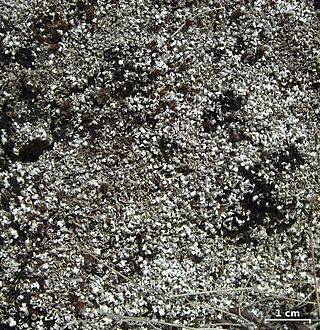
Lampsilis cariosa, the yellow lampmussel, is a species of freshwater mussel, an aquatic bivalve mollusk in the family Unionidae, the river mussels.

Apamea cariosa, commonly called the nondescript dagger moth, is a moth of the family Noctuidae. It is found in the northeastern United States, including New York, Maryland, Indiana and Virginia. In Canada it is found in Ontario, Quebec, New Brunswick, Alberta, and Manitoba.
Typhlomangelia cariosa is a species of sea snail, a marine gastropod mollusk in the family Borsoniidae.
Typhlomangelia is a genus of sea snails, marine gastropod mollusks in the family Borsoniidae, the cone snails and their allies.

Drupella is a genus of sea snails, marine gastropod mollusks in the family Muricidae, the murex snails or rock snails.

Acalolepta is a genus of flat-faced longhorns beetle belonging to the family Cerambycidae, subfamily Lamiinae. Its members are found in the Indomalayan realm.

Omphalocera cariosa is a species of snout moth, and the type species in the genus Omphalocera. It was described by Julius Lederer in 1863. It is found from North America to Brazil.
Acalolepta griseofasciata is a species of beetle in the family Cerambycidae. It was described by Stephan von Breuning in 1935, originally under the genus Dihammus. It is known from Papua New Guinea, Vanuatu, and the Solomon Islands.
Acalolepta magnetica is a species of beetle in the family Cerambycidae. It was described by Francis Polkinghorne Pascoe in 1866, originally under the genus Monochamus. It is known from Micronesia, Moluccas and Indonesia.

Acalolepta permutans is a species of beetle in the family Cerambycidae. It was described by Francis Polkinghorne Pascoe in 1857, originally under the genus Monohammus. It is known from Japan, Vietnam, Taiwan, and China. It feeds on Albizia julibrissin.
Acalolepta montana is a species of beetle in the family Cerambycidae. It was described by Per Olof Christopher Aurivillius in 1916. It is known from Sulawesi.
Acalolepta antenor is a species of beetle in the family Cerambycidae. It was described by Newman in 1842. The typical form is known from the Philippines, but numerous subspecies are widespread in Indonesia, Moluccas, Micronesia, New Guinea, Australia, Solomon Islands and Samoa.

Acalolepta fraudatrix is a species of beetle in the family Cerambycidae. It was described by Henry Walter Bates in 1873. It is known from Korea, Japan, China, and Russia.
Acalolepta mixta is a species of beetle in the family Cerambycidae. It was described by Frederick William Hope in 1841, originally under the genus Monohammus. It is known from Australia, and was introduced to the Solomon Islands, Indonesia, Singapore and Vietnam. It feeds on Theobroma cacao, Adansonia digitata, Mangifera indica, Excoecaria agallocha, and Moringa oleifera.
Acalolepta rusticatrix is a species of beetle in the family Cerambycidae. It was described by Johan Christian Fabricius in 1801, originally under the genus Lamia. It is known from Myanmar, India, the Philippines, Malaysia, Sumatra, Sri Lanka, Java, Taiwan, Indonesia, Sulawesi, and Vietnam.
Acalolepta sejuncta is a species of beetle in the family Cerambycidae. It was described by Henry Walter Bates in 1873. It is known from Japan.
Brochymena cariosa is a species of stink bug in the family Pentatomidae. It is found in North America.
Pterotaea cariosa is a species of geometrid moth in the family Geometridae. It is found in North America.

Cladonia cariosa, the split-peg lichen or the split-peg soldiers cup lichen, is a species of fruticose, cup lichen in the family Cladoniaceae. It was first formally named by Erik Acharius in 1799 as Lichen cariosus and transferred to the genus Cladonia in 1827 by Kurt Polycarp Joachim Sprengel. It has a broad distribution, occurring in Europe, Asia, North America, and South America.






